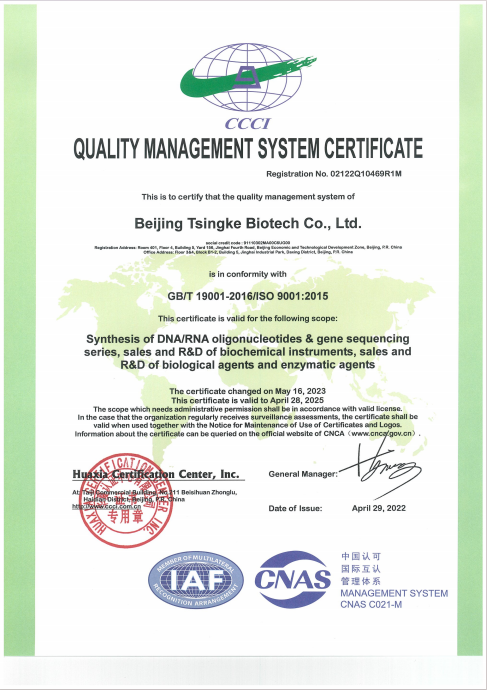Polymerase Chain Reaction (PCR) is a molecular biology technique invented by Kary Mullis in 1983. (Wikipedia, 2024) It is used to quickly and efficiently replicate specific DNA sequences in vitro.
Polymerase Chain Reaction (PCR) involves three main steps: First, the double-stranded DNA (dsDNA) is separated into single-stranded DNA (ssDNA) by heating, a process known as denaturation. Next, at a lower temperature, primers bind to the target DNA sequence in a step called annealing. Finally, at a moderate temperature, DNA polymerase synthesizes a new DNA strand in the extension step. These steps are repeated in cycles to amplify specific DNA segments.
The PCR technology has enabled scientists to obtain large quantities of specific DNA sequences quickly and accurately, facilitating genetic research, medical diagnostics, forensic science, and biotechnology.
PCR primer design is a critical component in the Polymerase Chain Reaction (PCR) process. Primers are short sequences of single-stranded DNA that are complementary to the ends of the target DNA sequence. These primers provide a starting point for DNA polymerase to begin synthesizing new DNA strands.
Accurate manufacturing of primers ensures that they bind specifically to the target DNA, which is essential for precise PCR amplification. Non-specific binding and amplification can lead to inaccurate results, making the process less reliable. Therefore, the design of PCR primers is crucial for the success of the PCR, ensuring specificity and accuracy in DNA amplification.
Understanding Primers
Understanding design principles of primers can help us better avoid potential issues that may arise during primer manufacturing. To design primers effectively, follow these guidelines:
● Length: Primers should typically be 18–25 bases long. This length ensures adequate specificity and efficient binding to the target sequence.
● Melting Temperature (Tm): The melting temperature of primers should be between 50°C and 72°C. Ideally, the Tm of both primers in a pair should be within 2–3°C of each other to ensure synchronous binding during the PCR process.
● GC Content: Primers should have a GC content of 40% to 60%. Low GC content can lead to weak binding, while high GC content can cause strong, nonspecific binding. Aim for a balanced GC content to maintain primer stability and specificity.
● Specificity: Primers must be designed to bind specifically to the target sequence. Avoid regions with secondary structures, repetitive sequences, or high similarity to non-target sequences to prevent nonspecific amplification.
● Secondary Structures: Avoid designing primers with secondary structures such as hairpins, self-dimers, or cross-dimers, as these can interfere with the binding efficiency and overall PCR process.
● 3' End Stability: Ensure that the 3' end of the primer has a strong binding affinity, typically with a GC clamp (a few G or C bases at the 3' end), to enhance the extension efficiency by DNA polymerase.
By adhering to these principles, you can design primers that are both efficient and specific for your PCR experiments.
In addition to knowing the principles of effective PCR primer design, the tools chosen for PCR primer design are critical. How to design primers? The main tools commonly used are:
● Primer3: It has a large number of parameters that are suitable for researchers designing more complex experiments.
● Primer-BLAST: Developed by NCBI, it combines the Primer3 platform and the BLAST algorithm.
● Primer3Plus: A user-friendly primer design interface based on the Primer3 platform.
Moreover, there are some pitfalls to be avoided during PCR primer design, such as generating secondary structure, primer-dimer formation, and mismatch. This will be described in detail in the next section.
Impact of Failed Primer Design on PCR
Careful primer design is crucial before conducting PCR because poorly designed primers can lead to nonspecific amplification and primer dimer formation. Here is a detailed explanation of these phenomena:
1. Nonspecific Amplification
Nonspecific amplification is a phenomenon in PCR where primers bind to multiple non-target DNA sequences, resulting in these sequences being amplified as well. It can produce unwanted DNA fragments.
Nonspecific amplification occurs because the primers polymerize into dimers or because there are multiple sites on the target sequence that are complementary to the primers. In this situation, experimenters need to redesign the primers. (Ruiz-Villalba A et al, 2017, pp, 7-18)
Nonspecific amplification can lead to multiple bands during gel electrophoresis analysis, making it difficult to interpret the results. Moreover, it may interfere with following cloning, protein expression, or other experiments.
2. Primer Dimer Formation
Primer dimer formation occurs when primers anneal to each other, forming a double-stranded structure. This typically happens due to:
Improper primer sequence design, particularly with complementary sequences at the 3' ends. Excessively high primer concentrations. Low annealing temperatures during PCR. Primer dimers consume primers and dNTPs, reducing the efficiency of PCR . They also form visible bands during gel electrophoresis, interfering with the analysis of the target product.
To mitigate primer dimer formation, consider the following measures: Optimize primer design to avoid complementary sequences at the 3' ends. Adjust primer concentration and annealing temperature appropriately. By understanding and addressing these issues, you can improve the efficiency and specificity of your PCR experiments.
Importance of PCR Primer Design and Choosing a Service Provider
Given the above impact of primer manufacturing on PCR, choosing primer design services provided by a professional service provider is critical to ensuring smooth experimentation and accurate results.
1. Need for Professional Primer Design Services
How to design primers effectively? First of all, professional service providers usually use advanced software and tools to ensure PCR primer design accuracy. They will consider factors affecting primer effectiveness, such as primer length, melting temperature, GC content, and specificity, to ensure that the primers can accurately amplify the target DNA sequence.
Secondly, professional service providers also stand out in the efficiency of primer design, shortening the waiting time for researchers.
Finally, professional service providers have rich experience in primer manufacturing and in-depth knowledge. This means that the probability of failure and waste of resources is greatly reduced.
2. Meeting Customer Gene Synthesis Needs with High-Quality PCR Primer Design Products
PCR primer design is of indispensable importance in gene synthesis and vector construction. Through high-quality raw materials, 99.5% synthesis efficiency, and strict purification standards, Tsingke is committed to providing high-purity primers to ensure efficient vector construction or gene synthesis.
Tsingke is equipped with an intelligent gene synthesis line to provide high-quality, efficient, and cost-effective plasmids up to 200kb in length. Clients can select from over 160 commercial vectors and benefit from complementary codon optimization services, ensuring the optimal expression of both prokaryotic and eukaryotic genes. Every plasmid undergoes meticulous NGS and Sanger sequencing. Moreover, leveraging a sophisticated nucleic acid sequence optimization algorithm, Tsingke streamlines sequence synthesis complexities while enhancing protein expression. With a turnaround time of just 5 days, you can obtain the desired synthesized gene is swift and hassle-free.

Conclusion
What is the purpose of careful primer design before PCR? Any mistakes in PCR primer design may lead to undesirable consequences, such as increasing the cost and time of the experiment. Therefore, effective primer manufacturing and the PCR cloning process are crucial to improving efficiency.
Choosing a professional service provider, such as Tsingke, can effectively avoid these problems and ensure the success and accuracy of the experimental results. Contact us for detailed, customized solutions!
References
Garibyan L, Avashia N. (2013) Polymerase chain reaction. J Invest Dermatol. 133(3), pp.1-4.
Hoy, M.A. (2019) 'DNA amplification by the polymerase chain reaction: providing a revolutionary method for all biologists,' in Elsevier eBooks, pp. 263–314.
Nicole K. (2021) Proven tips for PCR primer design [Online]. Available at: https://www.neb.com/en-us/nebinspired-blog/proven-tips-for-pcr-primer-design. (Accessed: 24 May 2024)
Ruiz-Villalba A, van Pelt-Verkuil E, Gunst QD, Ruijter JM, van den Hoff MJ. (2017) Amplification of nonspecific products in quantitative polymerase chain reactions (qPCR). Biomol Detect Quantif. 14:7-18.
Wikipedia (2024) Polymerase chain reaction [Online]. Available at: Onlinehttps://en.wikipedia.org/wiki/Polymerase_chain_reaction. (Accessed: 24 May 2024)






